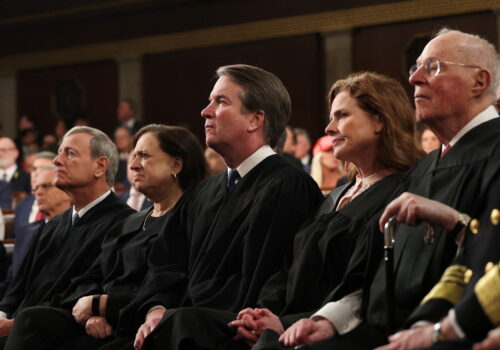JUST IN
Nine justices, one global economy-shaking case. The Supreme Court expressed skepticism of the Trump administration’s authority to use tariffs under the International Economic Emergency Powers Act (IEEPA) during oral arguments on Wednesday. The outcome of the case, which will be announced in the coming months, will have wide-ranging ramifications for the tariffs US President Donald Trump has enacted so far and his ability to levy them unilaterally in the future. How are the justices likely to rule? And what will their ruling mean for global trade? Our geoeconomics experts provide their arguments below.
TODAY’S EXPERT REACTION BROUGHT TO YOU BY
- Stephanie Connor: Contributor at the GeoEconomics Center’s Economic Statecraft Initiative, partner at Holland & Knight LLP, and a former senior official with the Office of Foreign Assets Control
- Josh Lipsky (@joshualipsky): Chair of international economics and senior director of the GeoEconomics Center, and former International Monetary Fund advisor
- L. Daniel Mullaney: Nonresident senior fellow with the Europe Center and GeoEconomics Center, and former assistant US trade representative
What is the case about?
- The Trump administration’s solicitor general faced “tough questioning” from the justices, Stephanie tells us, on whether IEEPA “authorizes the president to impose tariffs, a form of taxation generally reserved for Congress under Article I of the US Constitution.”
- The justices, says Josh, were “concerned about the limits” of the “sweeping power” of tariff authority under IEEPA and “how it could be used by future presidents to justify any kind of tax if a president deemed a situation to be an ‘emergency.’”
- This skepticism, says Dan, is “primarily because of tariffs’ revenue function,” since Article I states that Congress has the exclusive power to raise revenue. The Trump administration’s “arguments that the IEEPA tariffs were ‘regulatory’ tariffs, and not ‘taxes,’” says Dan, “fell relatively flat.”
Sign up to receive rapid insight in your inbox from Atlantic Council experts on global events as they unfold.
What did we learn from the oral arguments?
- What stood out most to Josh was “how aware the justices were of the practical and foreign policy implications of their decision.” The justices, Josh points out, brought up issues and policies their decision will impact, including Russia’s war in Ukraine and Trump’s tariffs on India and Brazil. “This is a court very aware of the geopolitics they may be about to disrupt with their decision.”
- The justices, says Stephanie, “did not take the bait” when it came to the larger question of whether a president’s emergency declarations are subject to judicial review, showing “considerable deference to the executive branch on such determinations.” So “whichever way the justices decide this case, the decision is unlikely to call into question” the president’s authority to determine a national emergency, she says.
- Discussion of the potential refunds of tariffs if the court sides with the plaintiffs was “limited,” says Dan, “aside from Justice Amy Coney Barrett suggesting that it would be a ‘mess.’”
- Dan also finds it “significant” that all four of the “swing justices”—John Roberts, Brett Kavanaugh, Neil Gorsuch, and Barrett—had skeptical questions for the Trump administration. Only two of them would need to side with the court’s three liberal justices to overturn the tariffs. “It seems more likely than not that this could be a 5-4 or 6-3 decision,” he adds.
What’s next?
- Even if the Supreme Court rejects or limits the president’s authority to levy tariffs under IEEPA, Dan points out that “the administration has many tools available to continue imposing tariffs on the grounds of national security, unfair trade practices, balance of payments, or discrimination against the United States.”
- Nevertheless, says Dan, “losing the extreme flexibility that the administration has claimed under IEEPA would make it harder to move quite as quickly” to enact tariffs as it has in the past few months.
- “The whole world was listening and thinking what it means for them,” Josh tells us of today’s oral arguments. “For both companies and countries, the answer is more uncertainty: When will the court rule? How will it rule? What back-up tariffs get put into place? When does that happen?” Being left with these unanswered questions, he adds, is a “challenging way to run a global economy.”
- “This is not academic,” says Josh. “There are hundreds of billions of dollars on the line and the president’s trade agenda may hinge on the outcome.”
Further reading
Tue, Sep 16, 2025
The Supreme Court’s decision on Trump tariffs will have lasting impact on US economic statecraft
Econographics By
Regardless of how the Supreme Court rules, the case will shape US economic policy for years to come.
Fri, Aug 1, 2025
How Donald Trump remade global trade
New Atlanticist By Josh Lipsky
The US president has smashed the system, but the speed and scale of the smashing owes to a system that had been growing increasingly brittle for years.
Tue, Aug 26, 2025
Trump’s economic agenda is set to collide with the Supreme Court
New Atlanticist By Josh Lipsky
The court will likely have to weigh in on both the president’s use of emergency powers and his escalating war with the Federal Reserve.
Image: The Supreme Court in Washington, D.C. is seen from the grounds of the US Capitol on July 13, 2022. Photo by Bryan Olin Dozier/NurPhoto.





